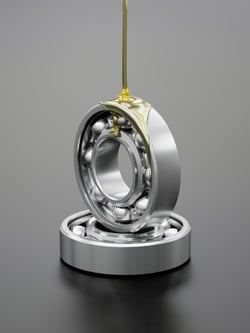When selecting bearings for your next project, there are three key factors to consider, which are also a function of the load being carried and the limiting or speed required. The friction, temperature, and lubrication involved in a system and its environment directly impact bearings, so it’s critical to select a bearing that has the proper tolerances for your application.
How Friction, Temperature, and Lubrication are Important to Overall Bearing Performance
Friction
Friction results in wear on a broad range of components, and bearings are no exception. Friction can directly cause thousands of dollars in damage to systems and machinery. Provided bearings are working under normal operating conditions, rolling bearings offer much lower friction coefficients than their slide counterparts—especially starting friction.
Temperature
Ideal operation temperatures will vary from bearing to bearing and from application to application, so it’s important to select bearings that can handle the temperatures of your operating environment. A bearing's operating temperature hinges on equilibrium between two factors: the amount of heat that a bearing generates and the amount of heat that's conducted away from that bearing.
In a majority of cases, bearing temperature follows this path:
- The temperature around a bearing rises sharply as initial operations begin.
- A slow increase in temperature continues to occur until a stable condition is reached.
- Temperature remains constant after this point.
The amount of time that it takes a system to reach a stable state varies based on several factors, such as:
- Heat capacity and diffusion capabilities of the shaft and bearing housing
- Amount of heat actually produced
- Lubrication selection
In events where temperatures continue rising for inordinate amounts of time, it must be assumed that a malfunction is occurring. Non-constant temperatures are red flags and should be assessed immediately.
Lubrication
Rolling bearings cannot operate reliably without adequate lubricant, which helps reduce friction and cut down on wear and tear. In some cases, lubricant aids the cooling a system as well.
When friction is converted into heat, that heat must be dissipated to avoid the risk of damage to the bearing. Selecting the proper lubricating oil can help dissipate a portion of the heat. Recirculating oil lubrication with additional cooling features implemented can be an effective cooling method. While grease does not offer any benefit in heat dissipation it is still the most popular form of lubrication. As a result the grease selected should have operating parameters appropriate to the application, NLGI density, temperature rating and service life.
How These Three Variables Work Together in Bearing Products
 Friction and grease resistance oftentimes work in tandem to increase bearing temperatures. When operations initially begin, it's typical to observe a rapid rise in temperature in the internal bearing. Eventually, heat will begin to gradually dissipate to the shaft and housing of the bearing and cooling effects from the lubricant will also begin to aid in stabilizing temperatures. There should be an awareness that too much grease can cause ‘churning’ and a resultant heat increase. The common rule is that bearings should have a 20%-30% fill of grease. Typically this would be filling every space between balls on one side of the bearing with grease.
Friction and grease resistance oftentimes work in tandem to increase bearing temperatures. When operations initially begin, it's typical to observe a rapid rise in temperature in the internal bearing. Eventually, heat will begin to gradually dissipate to the shaft and housing of the bearing and cooling effects from the lubricant will also begin to aid in stabilizing temperatures. There should be an awareness that too much grease can cause ‘churning’ and a resultant heat increase. The common rule is that bearings should have a 20%-30% fill of grease. Typically this would be filling every space between balls on one side of the bearing with grease.
When high temperatures become a constant issue, they can lead to reduced bearing clearance and a deterioration of the running accuracy and lubricant. These factors translate to a reduction in the lifespan of a bearing, which is why considering the effect of temperature increases is critical during the bearing selection process. Users may consider higher end ‘technical’ greases that can provide higher temperature ratings and a longer service life
If you're interested in learning more about which bearing type is best for your organization, download our eBook, Bearings 101, today.






